Regular Inspection Activity
In addition to the COVID-19 targeted QA activity, the following chart demonstrates the regular inspection activity that took place between 2019/21:
| Regular inspection activity | |
| 2019-2020 | 2020-2021 |
| 13 programmes | 7 programmes |
2019-2021 Regular inspection activity
The tables below outline a further breakdown of the programmes subject to a regular inspection in the 2019-2021 academic years:
| Regular inspection activity 2019-2020 | ||||
| Dentistry (BDS) | Dental hygiene and therapy (HT) | Dental technology (DT) | Orthodontic therapy (OT) | Dental nursing (DN) |
| 2 programmes | 5 programmes | 1 programme | 3 programmes | 2 programmes |
| Regular inspection activity 2020-2021 | |||
| Dental hygiene and therapy (HT) | Dental technology (DT) | Orthodontic therapy (OT) | Dental nursing (DN) |
| 3 programmes | 2 programmes | 1 programme | 1 programme |
Based on the inspection activity detailed above, more Requirements under Standard 1 (protecting patients) were met than Standard 2 (quality evaluation and review) and Standard 3 (student assessment) which is similar to the findings in the previous publications of the Review of Education.
The chart below demonstrates the number of Requirements that were considered to be “met” across all three Standards in the 2019-2021 period.
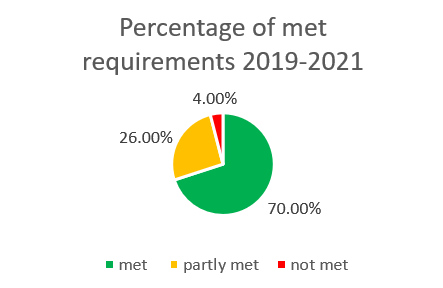
This chart provides a breakdown of the Requirements “met”, “partly met” and “not met” in each profession:
2019/20:
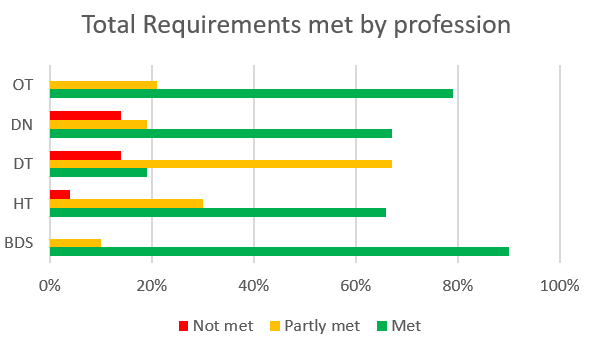
The chart below demonstrates the number of Requirements that were considered to be “met” across all three Standards in the 2020-2021 period:
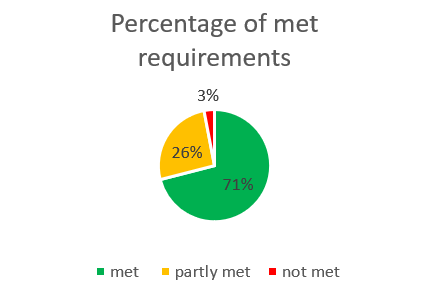
This chart provides a breakdown of the Requirements “met”, “partly met” and “not met” in each profession:
2020/21:
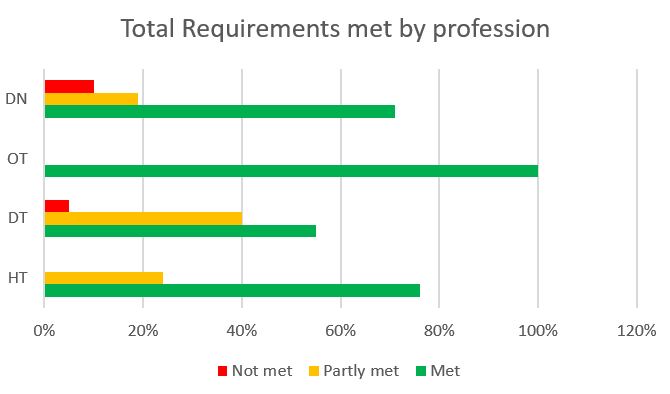
Standard 1 - Protecting patients (Requirements 1-8)
The charts below shows the percentage of Requirements “met”, “partly met” and “not met” across Standard 1:
2019/20:
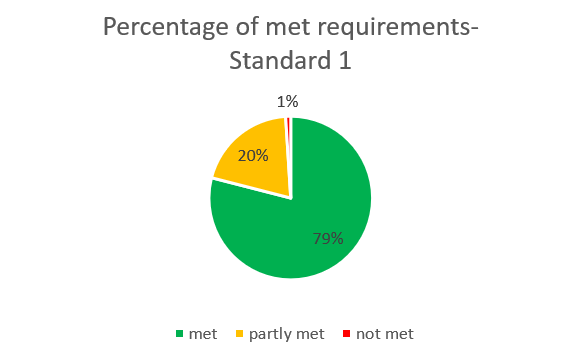
2020/21:
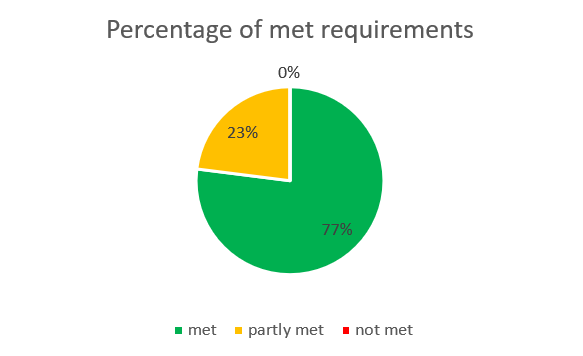
The chart below outlines a further breakdown per requirement for Standard 1 in the 2019/20 academic year:
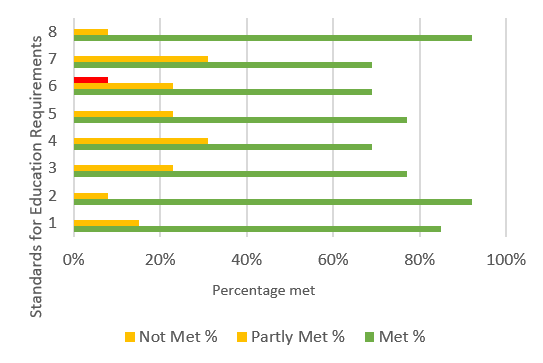
The chart below outlines a further breakdown per requirement for Standard 1 in the 2020/21 academic year:
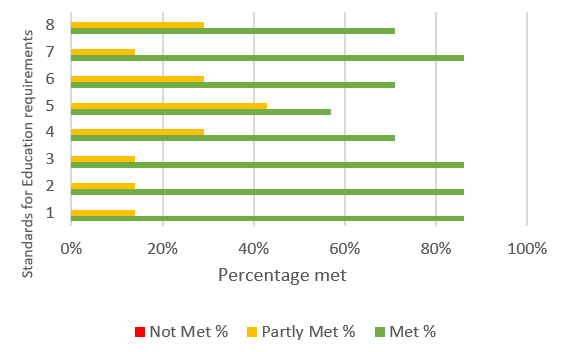
Within Standard 1, some Requirements were considered to be ‘party met’ or ‘not met’. The areas identified by the associates for improvement were as follows:
- Better recording and maintenance of accurate and contemporaneous student records.
- Greater use of audits of clinical activity.
- More effective student supervision and better contingency planning.
- Greater student and staff awareness of raising concerns.
- The recording of lessons learned from any adverse incidents.
- Improved recording of staff training records.
The providers involved were given specific actions to address these areas.
Examples of areas of good practice under Standard 1 included:
| Glasgow Caledonian University - HT |
| Requirement 4 |
| "The School reported high levels of nursing support - sometimes at a ratio of 1:1. The panel was pleased to note that nursing staff provide feedback on students and their performance.” |
| King's Health Partners - OT |
| Requirement 6 |
| "The student group were clearly able to articulate their responsibilities and awareness with regard to raising concern and the process to be followed. This assured the panel that the programme staff were evidently strongly embedding this aspect of knowledge throughout the programme.” |
| Bristol BDS |
| Requirement 8 |
| "A new process for dealing with student fitness to practice issues has been introduced. Multiple pieces of evidence about the process were provided to the panel who deemed the process to be robust. When triangulated, students reported that they have enjoyed the pastoral element introduced into the new process. The students also clearly understood the remit and purpose of the student referral system, which is part of the new process.” |
Standard 2 - Quality evaluation and review of the programme (Requirements 9-12)
The chart below shows the percentage of Requirements ‘met’, ‘partly met’ and ‘not met’ across Standard 2:
2019-2020:
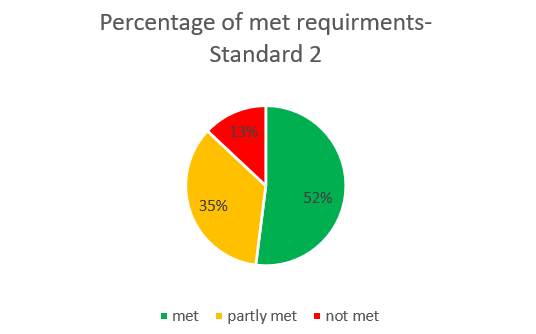
2020-2021:
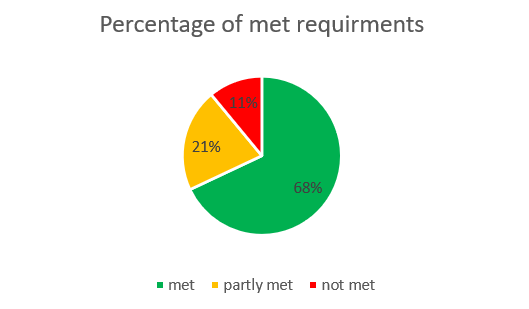
The chart below outlines a further breakdown per Requirement for Standard 2 in the 2019/20 academic year:
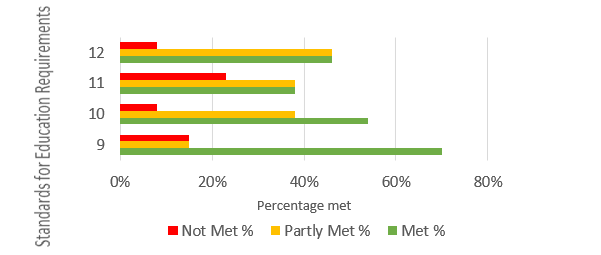
The chart below outlines a further breakdown per Requirement for Standard 2 in the 2020/21 academic year:
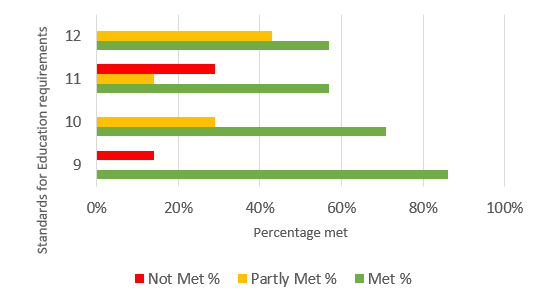
- The formalisation of more robust quality management arrangements accompanied by a comprehensive quality assurance document and dedicated quality assurance forum.
- Clearer recording of the mapping of GDC learning outcomes process.
- To develop a clearer risk register complete with contingency measures.
- To improve and formalise the use of external examiners (EE) and to enhance the EE reports.
Examples of areas of good practice under Standard 2 included:
| Teesside HT | |||||||
| Requirement 9 | |||||||
|
Standard 3 - Student assessment (Requirements 13-21)
The chart below shows the percentage of Requirements ‘met’, ‘partly met’ and ‘not met’ across Standard 3:
2019/20:
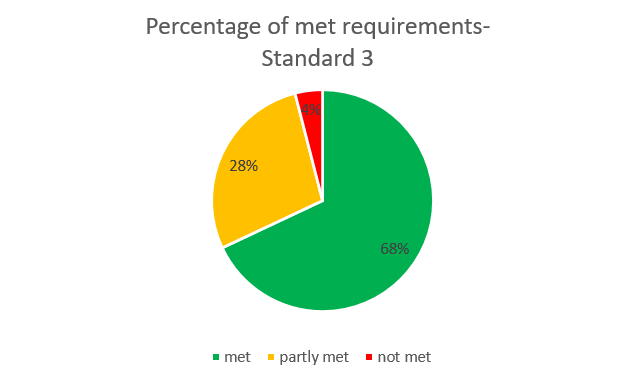
2020/21:
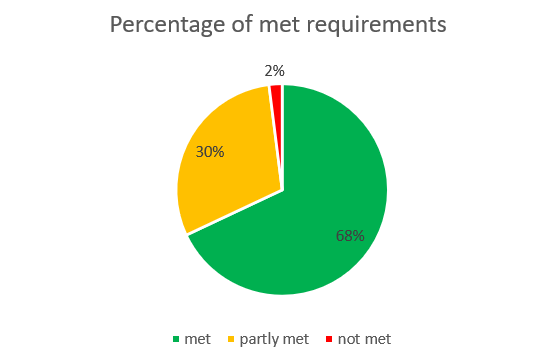
The chart below outlines a further breakdown per Requirement for Standard 3 in the 2019/20 academic year:
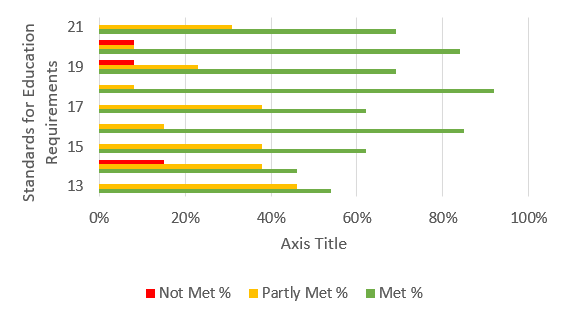
The chart below outlines a further breakdown per Requirement for Standard 3 in the 2020/21 academic year:
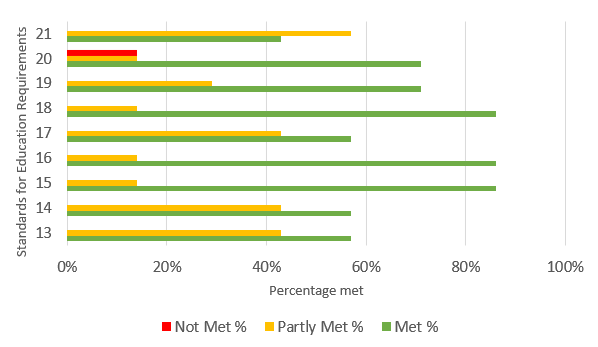
- To implement a more formalised process for identifying and monitoring struggling students outside of regular progression procedures.
- To review the use of totals in measuring student experience and competence.
- To improve recording systems for student clinical experience to facilitate easier monitoring of student progression.
- To improve the allocation of patients to students through a formal process so that students can share patients.
- To improve the recruitment of paediatric patients and allocate to students earlier in the programme.
- To develop the calibration of training supervisors.
- To implement and demonstrate appropriate standard setting methods for summative assessments.
Examples of areas of good practice under Standard 3 included:
| University of Warwick OT |
| Requirement 13 |
| “The panel saw previous minutes of the pre-examination board meeting (or sign-up meeting), which illustrate that various factors were considered to determine whether a student was eligible to take their final examinations. This included satisfactory completion of all modular assessments, demonstration of appropriate clinical experience in logbooks, a satisfactory attendance record, professionalism traffic-light cards, patient feedback, any adverse incidents or Fitness to Practice issues.” |
| Liverpool College DT |
| Requirement 15 |
| “The students themselves commented very positively that the program has been crucial for providing progression and experience in a number of areas outside of the ones they get within their respective laboratories, that they may not otherwise have developed. It is recognised that the combination of college and on-the-job learning maximises the opportunity for learners to gain an appropriate breath of experience across many areas.” |
| Edinburgh HT |
| Requirement 21 |
| “All assessments and dissertations are double marked to ensure fairness, and this allows calibration between new and experienced assessors. It was clear that all the standard assessment procedures for summative assessments are undertaken.” |
Postponed Inspections
Due to the COVID-19 pandemic, six inspections and seven exam inspections were postponed from the 2019/20 academic year. We were also unable to conduct the 9 inspections that are detailed above in the 2020/21 academic year, however we have built this into our plans for 2021/22.
| Postponed inspections 2019-2021 | ||||
| Dental hygiene and therapy | Orthodontic therapy | Dental technology | BDS | |
| Postponed inspections | 1 programme | 2 programmes | 2 programmes | 1 programme |
| Postponed exam inspections | 2 programmes | 2 programmes | 3 programmes | 0 programmes |
 eGDC
eGDC